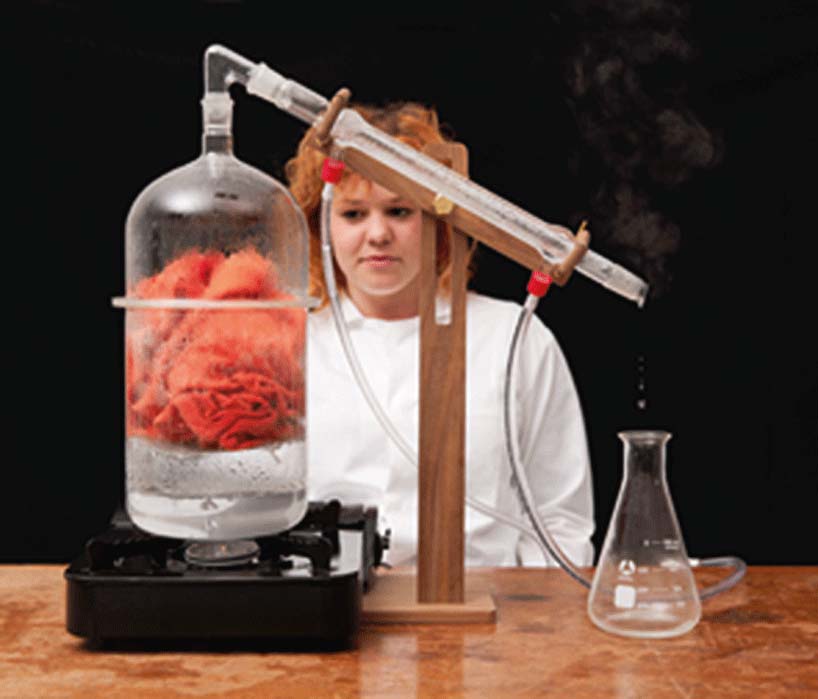
grandmas jumper by Olivia Alice from uk
designer's own words:
When keeping an item of clothing that belonged to a deceased loved one, it acts as an instant reminder; it can evoke memories and a sense of nostalgia. Some people may feel an obligation to retain an item simply due to its associations, even though it may be disliked aesthetically and never worn again. By extracting the essential elements that are embedded within the garment we might be able to keep the associated memories without having to retain the physical object.
“Of course, a loan from someone dead is temporary. It can’t be renewed and, eventually, the physical object begins to wear down” (Egan, Jennifer. “Dressed to Remember” The Sunday Times, (9th October, 2011) 27)
After reading an article in the Sunday Times by Jennifer Egan who described a jumper she had kept as a loan, I found this a truly stimulating and an intriguing idea. How can you loan an item from someone who is dead? This led into a wide investigation into death, but predominantly the grieving process that surrounds death, subsequently moving away from religious practices, and embracing the material culture in which we now live in. How can the tangible notion of materials be used to explore and design new ways to remember the deceased?
A garment can be broken down into its composite elements and by combining these together to create new objects; it will act as a new remembrance. It’s possible to distill a garment into an alcohol, which can then be used to toast the deceased.
A candle would use both scent and colour, but would not last forever, after each use it will slowly disappear similar to the life of the deceased, adding to that of the grieving process. If the colour from the garment could become a pigment, it might be possible to dye a plant and place it on the grave. These are all possibilities and possible uses for the essential elements that are embedded within a garment. My research showed that the essential and most important elements within a garment are the Scent, Colour and possible DNA.
Scent:
Smell acts as an instant emotional trigger. It links people together by an invisible thing that lingers among the threads of clothing. This invisible link acts as an emotional reminder of the deceased. Within seconds of you sniffing a scent you can be transported back to a single moment from your past, it’s the only sense that can do this so quickly. Smell is a powerful sense, we use it for almost everything we do and yet it is also one of the least researched. Smell gives us some 90 percent of what we taste.
We breathe 23,040 times in one day.
It takes 5 seconds to breathe, 2 to inhale and 3 to exhale.
Yet we recognize over 10,000 different odours, that’s just incredible!
Scent can be extracted from a garment in a hand-blown glass-distilling unit, which has been designed for clothing. As the steam rises from the boiling water, it moves through the fibres collecting the scent molecules. This steam continues to rise and flows through into the condenser, which has a jacket of cold water flowing around the outside. This causes the hot steam to cool quickly, locking in the scent molecules within, and dropping into the beaker below.
(see Image Labeled ‘Process’ and ‘Distilling kit’)
Steam distilling is a process that is used in the perfume industry to distill Rose oil. During this process the garment can lose some of the more delicate tones, which is unfortunate and cannot be helped. To retrieve the exact scent you can use a Gas chromatographer, a mobile version made by Headspace Technology and commonly used by Sissel Tolass (a scent designer and researcher). This machine reads the odour molecules, which are then converted to a computer to be read. At the International Flavors & Fragrances (IFF) lab the molecules can recreate an exact copy of the scent.
Colour:
Colour is an important aesthetic reminder of the garment and consequently the deceased. It’s attached to both organic and non-organic materials in very different ways. An organic material such as Cotton, the colour attaches to the side of the molecular cube structure, and is easily released. Acrylic, a non-organic material, the colour is locked inside of the molecular cube structure, to release the colour it would have to be knocked out of the cube.
Boiling the garment at a high temperature with a combination of chemicals, Soda crystals, Sodium Hydrosulfite and Caustic Soda allows the colour pigment to release itself into the boiling water.
(See Image Labelled ‘Process’)
DNA:
Clothing is worn close to our skin; it encases hair follicles and skin cells. DNA is so personal and individual and is something that shouldn’t be played with, especially in the circumstances after death. It may be best if returned to the deceased, scattered back on their grave. Its like you are returning a part of their missing body. If a forensic scientist was to remove the possible DNA from within the fibers it may be so small and virtually invisible. By cremating the garment, mirroring that of which the deceased may have undertaken, it would create DNA-rich ashes and would exist as a new form of ashes.
(see Image Labeled ‘Process’)
The Oak Chest:
The scent, colour and DNA will be carefully placed into individual bottles that will have the initials of the deceased etched on the top. These will come encased inside of an English Oak chest. This Chest will become the master collection housed in a similar looking chest to that of an urn. Inside of the chest will be a collection of 12 small vial bottles and inset in the drawer is a set of handcrafted tools specific for each element to be decanted. A pipette with a crocheted bulb allows the scent to be decanted into the smaller bottle. A glass funnel enables you to pour the colour into the smaller bottle and a dainty metal spoon allows you to scoop the DNA-rich ashes. Using a velvet red wax seal to ensure the elements stay inside, these can then be distributed amongst family and friends. The division of belongings can create many family arguments, by distributing the deceased’s legacy through the one jumper, which can be then divided into many smaller bottles, will reduce tensions among the family.
Once all three elements have been placed inside of the English Oak Chest the customer could keep the element locked away until the time is right to distribute. There are endless amounts of possibilities that both the scent and the colour can become. The elements can be kept as a remembrance, and they don’t ever have to be used, it’s the customer’s decision. The elements can either be used on their own, the colour could be used as a dye and the scent could be a perfume. Or together they could become a scented and colored candle. Here are a few other examples: Perfume, Potpourri, Beads, Candle, Soap, Oil, Colored paper, Clothing dye, Ink to write love letters, Dye Plants, and the list goes on.
DNA is such a personal element of the deceased and therefore may not be used for anything. It may be best to either keep it as a remembrance or return it back to the deceased. Returning the DNA is a similar to that of scattering the ashes.
How to access the Service:
At the time of a funeral people become very flustered with what is happening and are in mourning. Often people become very bamboozled with all the paperwork required and concentrate all their energy on getting the funeral over with. Therefore I believe that this service is an addition that can occur at anytime when the family feels able. It could be carried out for the deceased birthday, anniversary or to mark a special occasion. This service is an addition to aid the grieving process, to ease family tensions and to act as a new form of memorializing.
Advertising a service that is about remembering the dead is challenging, we perceive death as a scary taboo that’s not to be discussed. There are no set rules to follow, yet still its rare to advertise death related subjects as a TV advert or on a billboard. This is slowly changing as The Co-Operative supermarket now does funerals and is widely advertising on television. I believe that in our materialistic world we need to begin to change this, death shouldn’t be a scary taboo. With services like ‘Grandmas’ Jumper’ that are a personal and unique way of memorializing, which should be explained and advertised to allow more families to see what is out there. From billboard to television adverts and the commonplace Information booklets at the funeral director will inform families about possible future forms of memorializing.
Production/manufacture:
“Grandmas’ Jumper’ service will pride its self on a unique and personal service. With service at the heart of the company the production will not suffer. In a studio/shop/workshop space all three process can be carried out. With a studio space with 3 distilling units, space for 3 colour extracting pots and 2 garment cremation units. Running all these at their full capacity with two - three members of staff operating the equipment.
Scent can take between 0.5hours – 1 hour.
Colour can take between 1 hours – 2 hours.
DNA can take between 0.25 hours – 0.5 hours.
Taking these timings into account and normal working hours two members of staff could complete 12 complete sets in one day.
As this service is about having a personal memorial it is essential that the customer has the option to take part in the process. At a studio/shop location the customer can take part all three process, to then finally placing the bottles in a hand crafted Oak Chest. This additional service will come at an extra cost.
The English oak chest can be CNC routed to the specific measurements and then assembled. The glass bottles and the small vials can be purchased from manufactures in China. Finally the tool in the drawer, the funnel and stamp are readily available as is the red sealing wax. The spoon can be adapted to a snuff spoon that already exists and the pipette is an adaption of a perfume atomizer. Using a threaded brass tube that has a tapering nib and a perfume atomizer with a crochet bulb can achieve the pipette.
There are many possibilities within this service of added additional layers. Here is a list of possible packages of which ‘Grandmas’ Jumper’ could offer:
1. A simple but elegant package, where the customer receives the scent, colour and DNA-rich ashes in personalized etched bottles. These come encased within a small Box.
2. Some people may feel that not all elements are important to them. The customer could choose which of the three elements are essential to them.
3. All three elements housed inside of an English Oak chest, with 12 small vials and a set of decanting tools.
4. All three elements housed inside of an English Oak chest, with 12 or more vials and a set of decanting tools.
5. The chest can be made in a variety of different woods according to what the customer requires (Walnut, Cherry, Ash, Beech, Maple, Teak, etc) varying prices.
6. The luxury package contains all elements within the Oak chest with 12 small vials and the set of decanting tool with an additional half-day experience in helping to extract and distill all elements.
“Grandma’s Jumper’ is a personal and unique memorializing service that would offer to distill three of the most important elements embedded within a garment. Scent an instant evoker of memories and nostalgia, colour an aesthetic and visual reminder and finally the hair and skin follicles of the deceased encapsulated in DNA-rich ashes. A coloured liquid, a steam distilled scent and DNA-rich ashes will be housed inside of an English Oak chest. By deconstructing the garment and extracting its composite and essential elements, we might be able to keep the associated memories without having to retain the physical object. These substances could then exist as a new set of memorials, which may be distributed amongst relatives or utilised in new ways.
View a short video on vimeo: https://vimeo.com/41585975
View my Website at: http://www.oliviaalicedesign.co.uk/
Twitter: @olivia_alice_
Instagram: _olivia_alice
Blog: http://oliviaaliceclemence.blogspot.co.uk/
Thanks for reading this and I look forward to hearing from you soon.
This is the scent distilling kit. 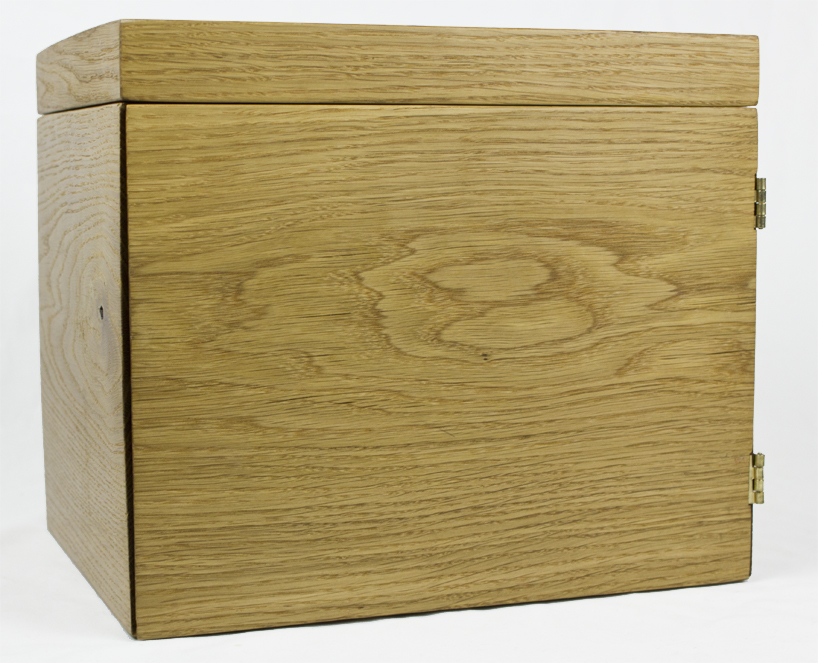 The English Oak chest to house all three elements (scent, colour, DNA)
The English Oak chest to house all three elements (scent, colour, DNA)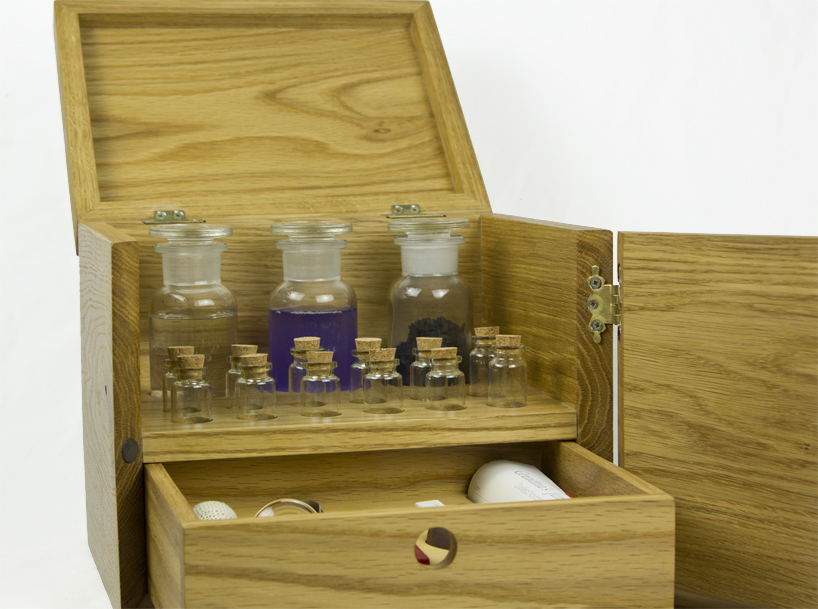 Inside of The Oak Chest, The scent, Colour and DNA are inside of glass bottles etched on the top with the initials of the deceased. There are 12 smaller vials, to allow division of the elements. Inside of the drawer is a set of decanting tools.
Inside of The Oak Chest, The scent, Colour and DNA are inside of glass bottles etched on the top with the initials of the deceased. There are 12 smaller vials, to allow division of the elements. Inside of the drawer is a set of decanting tools. The tool which enable the decanting process. The pipette is for the scents, the glass funnel the colour and the spoon for the DNA. Finally a wax seal set for those who wish to seal that precious bottle.
The tool which enable the decanting process. The pipette is for the scents, the glass funnel the colour and the spoon for the DNA. Finally a wax seal set for those who wish to seal that precious bottle.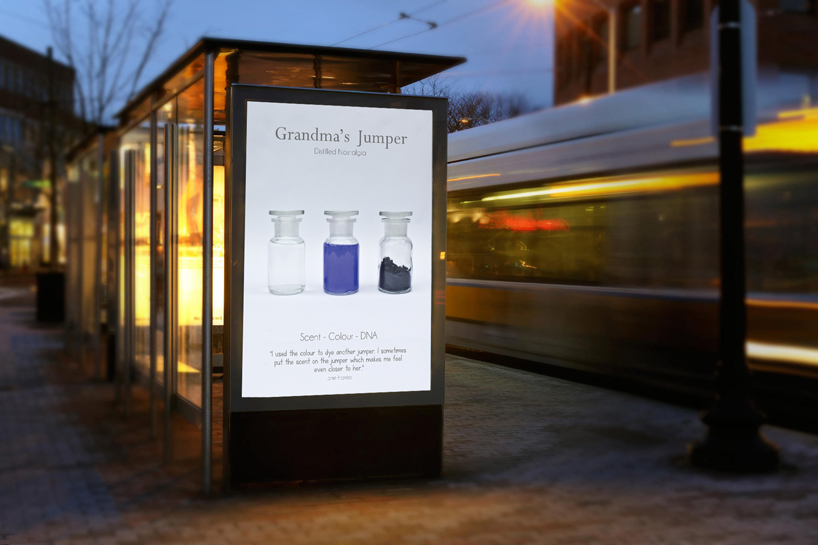 A possible bus stop advert to advertise the service.
A possible bus stop advert to advertise the service. 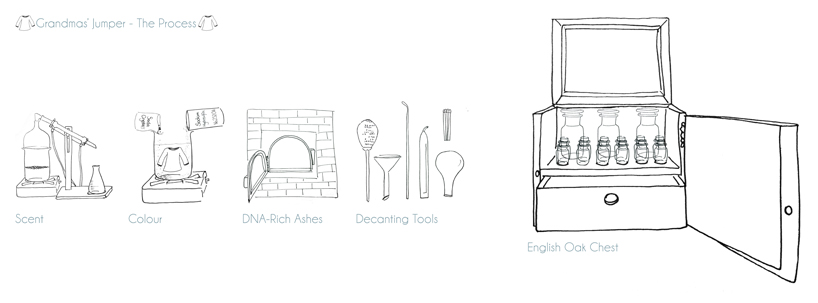 Sketch of the three process. Scent distilling, Colour extraction and creating the DNA rich ashes.
Sketch of the three process. Scent distilling, Colour extraction and creating the DNA rich ashes.